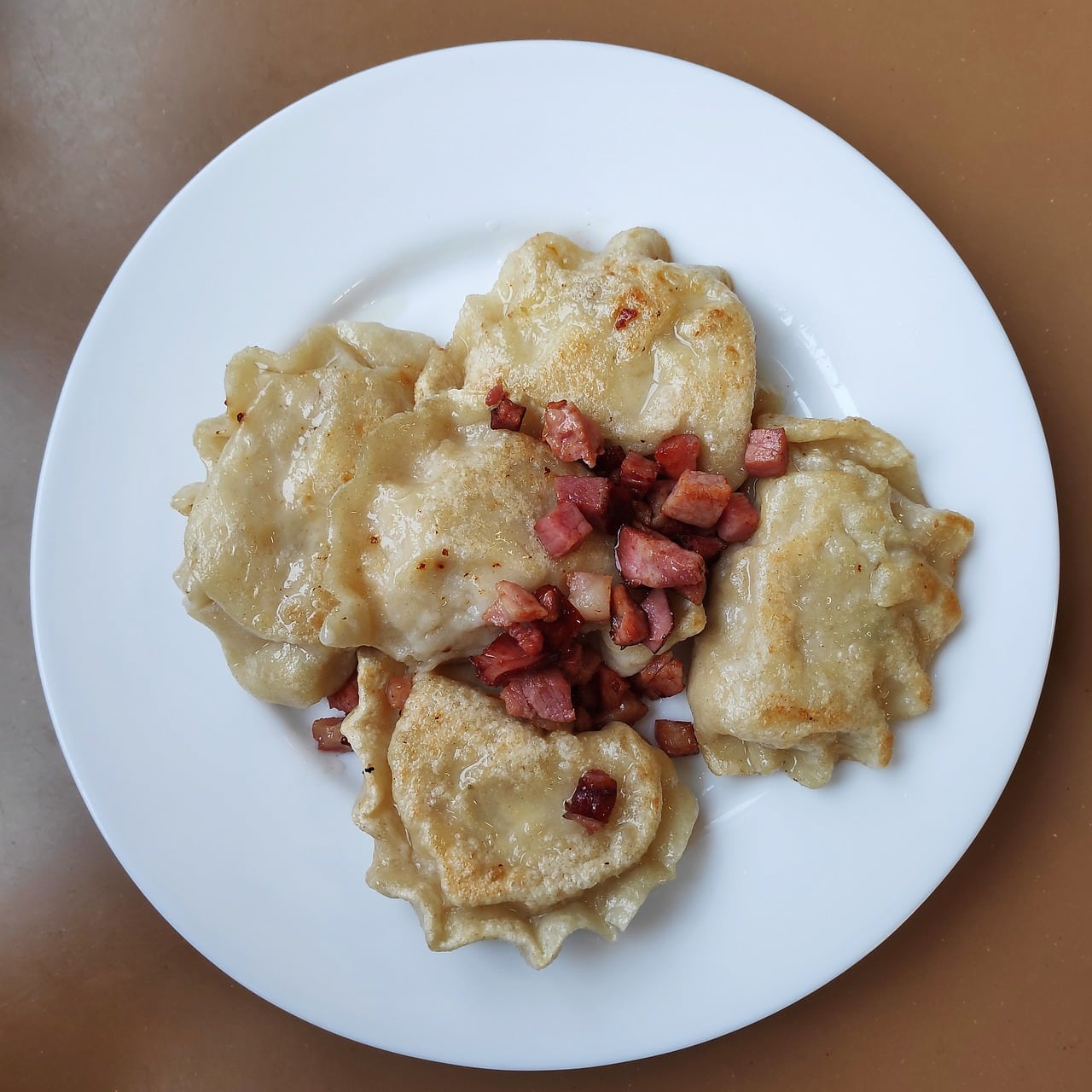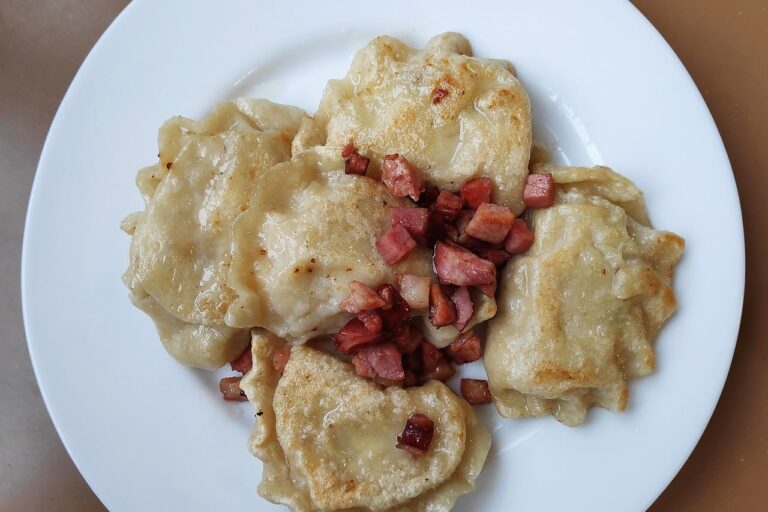
Pierogi, a national dish of Poland, is a culinary delight that has won hearts worldwide. These dumplings, filled with various ingredients, are a testament to the rich and diverse Polish cuisine.
Our team at Remitly created this guide as part of our series that celebrates the traditional foods of our global customers.
The History of Pierogi in Poland
The history of pierogi in Poland dates back several centuries. It’s believed that they were introduced by Saint Hyacinth of Poland, who brought them from East Asia. Over time, these dumplings became an integral part of Polish culture and cuisine.
In the past, pierogi were considered peasant food because of their simple ingredients. However, they gradually gained popularity among all social classes. Today, they’re acknowledged as a national dish and are often used in celebrations and family gatherings.
The Making of Pierogi: Ingredients and Preparation
Making pierogi involves two main steps: preparing the dough and making the filling. The dough is usually made from flour, eggs, water, and sometimes sour cream for added richness.
The filling varies widely based on personal preference and regional influences. Some popular fillings include mashed potatoes with cheese (pierogi ruskie), meat, sauerkraut with mushrooms, or fruit fillings like strawberries or plums.
Once filled, the dumplings are boiled until they float to the top. They can also be pan-fried for a crispy exterior. Despite their seemingly complex preparation process, making pierogi at home can be quite enjoyable.
A Simple Pierogi Recipe
Here’s a simple recipe for potato and cheese pierogi, also known as pierogi ruskie.
Ingredients
For the Dough:
– 2 cups of all-purpose flour
– 1/2 cup of water
– 1 egg
– 1 teaspoon of salt
– Optional: 2 tablespoons of sour cream for added richness
For the Filling:
– 2 large potatoes, peeled and boiled
– 1 cup of grated cheese (cheddar or cottage cheese work well)
– Salt and pepper to taste
Instructions
- Start by making the dough. Combine the flour, water, egg, salt, and optional sour cream in a bowl. Knead until smooth. Let it rest for about half an hour.
- While the dough is resting, prepare your filling. Mash the boiled potatoes and mix with grated cheese. Season with salt and pepper.
- Roll out your dough on a floured surface until it’s about 1/8 inch thick.
- Cut out circles using a cookie cutter or glass.
- Place a spoonful of filling in each circle, fold over to create a half-moon shape, and press edges together to seal.
- Boil pierogis in salted water until they float to the top (about 3 minutes). Optionally, you can pan-fry them afterward for a crispy exterior.
- Serve hot with sour cream or fried onions.
Varieties of Pierogi Across Regions
There’s no one-size-fits-all when it comes to pierogi. Different regions have their own unique versions. In the Kraków region, for instance, mushroom and cabbage fillings are favored during Christmas Eve dinner.
In the Silesia region, on the other hand, you’ll find “Silesian Dumplings” which aren’t technically pierogis but share similarities—they’re smaller with a potato-based filling served with gravy or butter.
This diversity reflects the regional differences in Poland and adds to the charm of this beloved dish.
Traditional Occasions for Serving Pierogi
Pierogi are often served during special occasions and holidays. Christmas Eve, known as Wigilia, is one such occasion where pierogi with sauerkraut and mushroom filling are a staple.
Easter is another holiday where pierogi makes an appearance. Here, they’re usually filled with fresh cheese, chives, or meat. Apart from these holidays, pierogi are also enjoyed on casual days, making them a versatile dish suitable for any occasion.
Popular Pairings with Pierogi
While delicious on their own, pierogis can be paired with various accompaniments to enhance their flavor. A dollop of sour cream is a common pairing that adds a tangy contrast to the savory fillings.
For sweet pierogis, a sprinkle of sugar or a drizzle of fruit syrup works well. Some people also enjoy their pierogis with fried onions or bacon bits for added crunch and flavor. The possibilities are endless when it comes to enjoying these delightful dumplings.
How to Enjoy Pierogi at Home
Enjoying pierogi at home is easier than you might think. Frozen versions are readily available in many supermarkets worldwide, which can be boiled or pan-fried as per preference.
If you’re up for some culinary adventure, though, making them from scratch can be quite rewarding. There are various recipes online that guide you through the process step by step.
Polish Restaurants Known for Their Pierogi
Poland boasts numerous restaurants that serve mouth-watering pierogis. In Warsaw, Zapiecek Polskie Pierogarnie is well-known for its wide variety of homemade dumplings while in Kraków, Przystanek Pierogarnia serves up traditional flavors loved by locals and tourists alike.
Outside Poland, there are also Polish restaurants serving authentic pierogis. From New York to London, the influence of the Polish diaspora has made this dish globally recognized.
The Broader Cuisine of Poland
Polish cuisine is diverse and hearty, reflecting its history and cultural influences.
Traditional Polish Dishes
Apart from pierogi, there are many other traditional dishes that are worth trying:
Bigos: Often referred to as Poland’s national dish after Pierogi, Bigos is a savory stew made from sauerkraut, various meats and sausages, and often prunes for a touch of sweetness.
Golabki: These are cabbage rolls filled with a mixture of rice and meat, then baked in a tomato sauce.
Zurek: This is a sour rye soup often served in a bread bowl. It’s typically made with sausage and hard-boiled eggs.
Polish Desserts
Polish desserts are just as delightful as their savory counterparts:
Paczki: These are Polish doughnuts that are usually filled with rosehip jam and covered with powdered sugar or glaze.
Makowiec: A poppy seed roll that’s often enjoyed during Christmas and Easter.
Polish Beverages
Poland is also known for its beverages:
Vodka: Poland is one of the top producers of vodka in the world. It’s often enjoyed neat or used in cocktails.
Piwo (Beer): Beer is popular in Poland, with many local breweries producing a variety of styles.
In conclusion, Polish cuisine offers an array of flavors to explore. From hearty stews to sweet pastries, there’s something for everyone to enjoy.
Visit the homepage, download our app, or check out our Help Center to get started.
